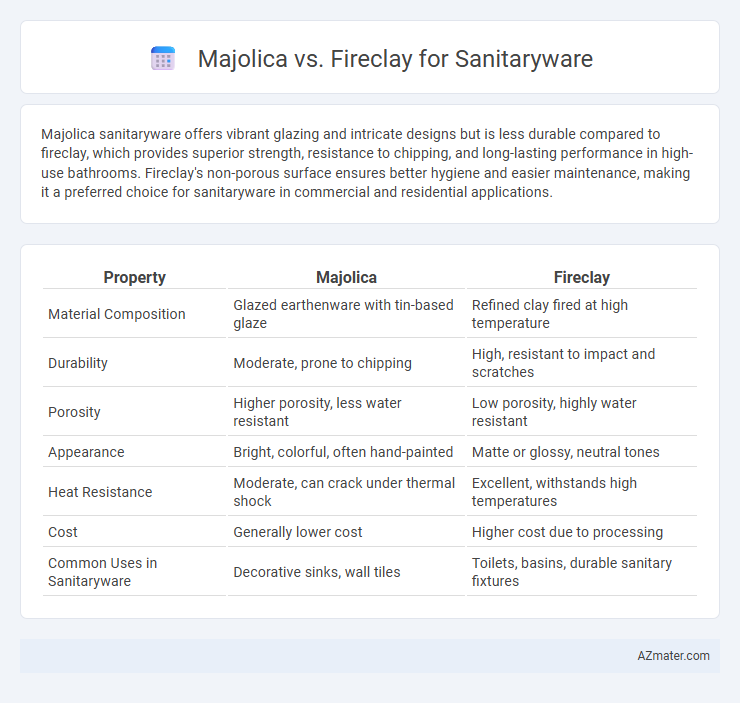Majolica sanitaryware offers vibrant glazing and intricate designs but is less durable compared to fireclay, which provides superior strength, resistance to chipping, and long-lasting performance in high-use bathrooms. Fireclay's non-porous surface ensures better hygiene and easier maintenance, making it a preferred choice for sanitaryware in commercial and residential applications.
Table of Comparison
| Property | Majolica | Fireclay |
|---|---|---|
| Material Composition | Glazed earthenware with tin-based glaze | Refined clay fired at high temperature |
| Durability | Moderate, prone to chipping | High, resistant to impact and scratches |
| Porosity | Higher porosity, less water resistant | Low porosity, highly water resistant |
| Appearance | Bright, colorful, often hand-painted | Matte or glossy, neutral tones |
| Heat Resistance | Moderate, can crack under thermal shock | Excellent, withstands high temperatures |
| Cost | Generally lower cost | Higher cost due to processing |
| Common Uses in Sanitaryware | Decorative sinks, wall tiles | Toilets, basins, durable sanitary fixtures |
Introduction: Majolica vs Fireclay in Sanitaryware
Majolica and fireclay are two prominent materials used in sanitaryware, each offering distinct properties and aesthetic appeal. Majolica, known for its vibrant glazes and detailed patterns, is a ceramic material prized for decorative bathroom fixtures like sinks and toilets. Fireclay, composed of refined clay fired at high temperatures, provides exceptional durability, resistance to chipping, and a smooth, non-porous surface ideal for high-use sanitaryware.
Material Composition and Manufacturing Process
Majolica sanitaryware is primarily composed of a refined clay body coated with a tin glaze, creating a smooth, brightly colored surface achieved through a high-temperature firing process. Fireclay sanitaryware uses a dense, vitrified clay mixed with quartz and feldspar, fired at extremely high temperatures to produce a highly durable, non-porous, and chip-resistant finish. The manufacturing of Majolica involves traditional glazing techniques for decorative appeal, while Fireclay's process emphasizes durability and resistance, making it ideal for heavy-use bathroom fixtures.
Durability and Strength Comparison
Fireclay sanitaryware exhibits superior durability and strength compared to majolica due to its dense composition and high firing temperature, making it highly resistant to chipping, cracking, and heavy impact. Majolica, while aesthetically versatile with its glazed surface, tends to be more porous and prone to wear over time, compromising its long-term structural integrity. For applications requiring robust performance and longevity, fireclay remains the preferred material in the production of sanitary fixtures.
Aesthetic Appeal and Design Options
Majolica sanitaryware offers vibrant, hand-painted surfaces that provide unique, artisanal aesthetic appeal, making each piece a statement of traditional craftsmanship. Fireclay sanitaryware features smooth, durable finishes with a wide range of shapes and sizes, allowing for modern and versatile design options suitable for contemporary bathrooms. Both materials excel in customization, but Majolica emphasizes decorative artistry, while Fireclay prioritizes sleek, minimalist designs with enhanced durability.
Resistance to Stains and Chemicals
Majolica sanitaryware features a glazed surface that provides moderate resistance to stains and chemicals, making it suitable for daily household use but potentially vulnerable to harsh cleaning agents. Fireclay sanitaryware, composed of a dense clay mixture fired at high temperatures, offers superior resistance to staining, chemical corrosion, and acidic substances, ensuring long-lasting durability in both residential and commercial bathrooms. The inherent strength and non-porous nature of fireclay surfaces result in easier maintenance and enhanced protection against discoloration compared to majolica.
Maintenance Requirements and Cleaning Ease
Majolica sanitaryware typically requires gentle cleaning with non-abrasive cleaners to preserve its glossy, decorative surface, as harsh chemicals can cause damage or discoloration. Fireclay, known for its durability and resistance to scratches and stains, allows for more aggressive cleaning without compromising its finish, making it ideal for high-traffic bathrooms. Both materials benefit from regular wiping to prevent soap scum buildup, but fireclay offers superior maintenance ease due to its robust, non-porous nature.
Cost Differences and Value for Money
Majolica sanitaryware typically offers a lower upfront cost compared to fireclay due to its less dense composition and simpler manufacturing process. Fireclay, made from a mix of clay and other minerals fired at higher temperatures, provides greater durability and resistance to chipping, which translates into longer lifespan and fewer replacements. While Majolica is budget-friendly for short-term installations, fireclay represents better value for money through enhanced durability and sustained aesthetic appeal.
Environmental Impact and Sustainability
Majolica sanitaryware is made from traditional clay fired at lower temperatures, resulting in less energy consumption and reduced carbon emissions compared to fireclay. Fireclay requires higher firing temperatures, increasing its carbon footprint despite its durability and resistance to chipping. Both materials are recyclable and biodegradable, but Majolica's lower energy production process makes it a more sustainable choice in eco-friendly bathroom design.
Popular Applications in Modern Bathrooms
Majolica sanitaryware, known for its intricate, colorful glazing and vintage charm, is popular in boutique hotel bathrooms and custom-designed residential spaces seeking artistic flair. Fireclay sanitaryware, valued for its durability, non-porous surface, and resistance to scratches, widely fits high-traffic modern bathrooms such as commercial restrooms and family homes prioritizing longevity and easy maintenance. Both materials are favored in contemporary bathroom designs, with Majolica enhancing aesthetic appeal and Fireclay ensuring functional performance.
Choosing the Right Material for Your Needs
Majolica sanitaryware offers vibrant, hand-painted designs with excellent moisture resistance, ideal for decorative bathroom fixtures that emphasize aesthetic appeal. Fireclay, made from refined clay fired at high temperatures, provides superior durability, scratch resistance, and long-term performance, making it perfect for high-traffic or commercial bathroom installations. Selecting between Majolica and Fireclay depends on prioritizing either artistic detail and color variety or robust strength and longevity in your sanitaryware.

Infographic: Majolica vs Fireclay for Sanitaryware
 azmater.com
azmater.com